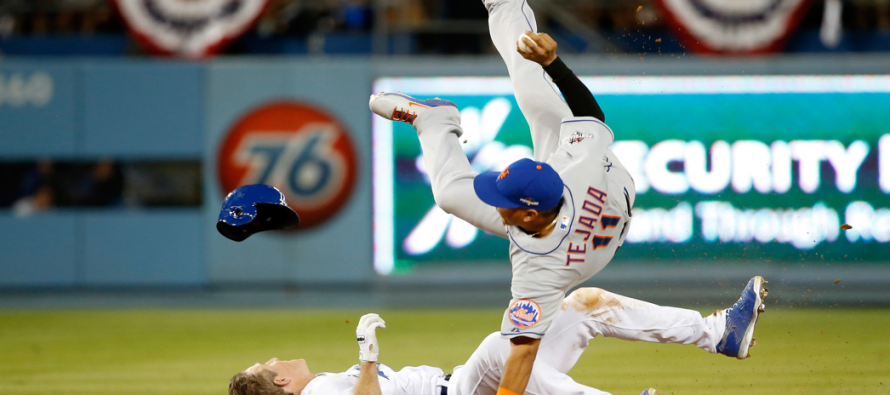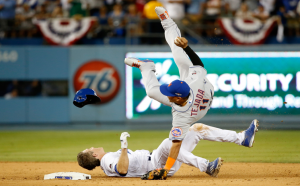MLB strides to a safer game

By Christian Bouchard

Chase Utley (bottom) slides into New York Mets infielder Ruben Tejada. The slide left Tejada injured and has since been a large reason in MLB’s new rule implementation of player safety when sliding into second base. (Photo courtesy of forbes.com)
Major League Baseball is back at it. More rule changes.
MLB has been inspired to help make a difference, after a scary slide by Chase Utley which led to the injury of Ruben Tejada.
This season there will be a 30 second clock, much like in basketball, timing the length of mound visits. The clock will start the moment the manager leaves the dugout and will be displayed on an in-stadium clock viewable for all.
While the efforts to speed up the game is admirable, MLB didn’t stop there. They also announced more clarification on the classic rule of players sliding into second base.
The 30 second manager’s clock is MLB’s way of trying to cut down on wasted time. Far too often did managers lollygag out to the pitcher’s mound just to give his relief pitcher a few extra warm up pitches.
The second rule implemented on Feb. 25 was one that would attempt to cut down on catastrophic injuries at second base when runners try to break up a double play. It also makes the “neighborhood play” — when a fielder doesn’t actually touch second base but gets an out because he was near the bag — reviewable by replay.
The slide rule, much like the pitch clock, operates in a related fashion. It starts by stating what a runner can do by charting four main views of a legal slide into second base:
- Slide prior to reaching the base.
- Slide so you are able to and attempt to reach or touch the base.
- Slide so you are able to and attempt to stay on the base.
- Do not change your pathway to the base.
In essence, a runner who follows those four rules is allowed to attempt to take out the player.
Expect this rule to encourage fielders to stand on the back of second base, where they’d likely be safe if the runner takes by the new regulations. Slides that do not will result in an automatic double play.
Making the neighborhood play reviewable brings up a number of questions. Not just about how the extra replays could add to the length of the game but regarding safety of the players.
Middle infielders have relied on the neighborhood play to prevent injury when attempted double plays are broken up. Subjecting the neighborhood play to review will be the biggest sign yet that players are willing to adapt to the new slide rules in order to keep one another safe. The players want safety and so does the league.
Injuries to Pirates infielder Jung-ho Kang and Mets shortstop Ruben Tejada forced MLB to reconsider its stance on slides into second. This is just a small portion of a large list of injuries, including concussions.
In fact, MLB, the union and umpires watched videos of about 20 plays at second base. Every video contained debatable slides and after watching attentively, the umpires formed a settlement on which were legal and which weren’t. From there, they looked for consistencies among the slides, good and bad, and made an attempt to find a rule that would require the least amount of interpretation among umpires.
The results were as follows:
Beginning this season, no longer will players be allowed to kick their legs out above a fielder’s knee, start their slide after the bag or roll into a fielder. While umpires were previously advised to call such moves illegal, the rules are now official. MLB hopes the newly added rule will encourage runners to slide into second base with greater consideration.
Finally, action has been taken, realizing the importance of player safety in the game. With the increase of Tommy John surgery and manager’s taking more action towards protecting their superstars and their mega contracts, safety is a definite concern. Pitchers such as Stephen Strasburg and Matt Harvey are now subject to an inning limit in order to preserve their arms and cut down on the chances of injuries. Like any sport, at any level, injuries can occur at any moment. Despite a traditional thinking of not messing with what isn’t broken, MLB has nailed it on the head with this rule.
Because of this new rule, the league and players can be successful for years to come.
Kudos to you, MLB.


